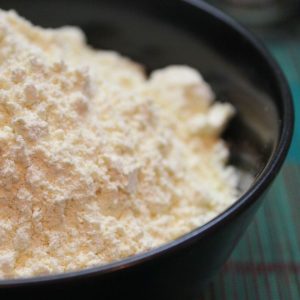 Partially Hydrolysed Guar Gum (PHGG): A Gentle Yet Powerful Prebiotic for Gut Health
Partially Hydrolysed Guar Gum (PHGG): A Gentle Yet Powerful Prebiotic for Gut Health
Digestive health is fundamental to overall wellbeing, influencing everything from nutrient absorption to immune function and even mood. When your digestion is working smoothly, you’re more likely to feel energised, clear-headed and comfortable throughout the day. Partially Hydrolysed Guar Gum (PHGG) is a well-established prebiotic fibre that can help support digestive health. With its well-researched benefits for gut microbiota and digestive function, it offers a gentle yet effective way to promote digestion without the bloating and discomfort often associated with other fibres.
What Is PHGG?
PHGG is a water-soluble dietary fibre made through enzymatic hydrolysis of guar gum, breaking it down into smaller, more digestible molecules. Unlike traditional guar gum, which is often used as a thickener in food products, PHGG dissolves easily without gelling or thickening. This makes PHGG a well-tolerated prebiotic fibre with a range of benefits for gut and metabolic health. Notably, PHGG is gluten-free and has also been recognised as low in FODMAPs by Monash University, making it suitable for individuals following a low-FODMAP diet.
Fibre vs. Prebiotic Fibre – What’s the Difference?
Most dietary fibres support digestion in some way, but only some qualify as prebiotics. Dietary fibres are plant-based carbohydrates that resist digestion in the small intestine and reach the colon, where they support the digestive system in various ways. However, prebiotic fibres are unique in that they are selectively used by beneficial gut bacteria to provide measurable health benefits.
According to the International Scientific Association for Probiotics and Prebiotics (ISAPP), a prebiotic is “a substrate that is selectively utilized by host microorganisms conferring a health benefit”. This means they don’t just pass through the gut—they actively nourish beneficial bacteria, supporting gut health and overall wellbeing.
PHGG is a great example. It is a fermentable, prebiotic fibre that selectively nourishes beneficial gut bacteria and promotes digestive health.
Why Prebiotic Fibre Matters for Gut Health
Your gut microbiome thrives on fibre-rich foods that serve as fuel for beneficial bacteria. Prebiotic fibres like PHGG help nourish and support the growth of key microbial species, promoting a diverse and resilient microbiome that enhances digestive function.
Many people struggle to get enough fibre from their daily diet leading to issues like sluggish digestion, irregularity and gut discomfort. PHGG provides a simple, effective way to boost fibre intake while supporting long-term gut health.
The Benefits of PHGG
Supports digestive regularity
PHGG gently promotes regularity, helping the digestive system function smoothly without the harsh effects of laxatives. Unlike some fibres that can cause bloating or cramping, PHGG is gentle on the gut and usually well-tolerated by those with sensitive digestion.
Feeds beneficial gut bacteria
PHGG selectively nourishes beneficial gut bacteria, particularly butyrate-producing species, which produce short-chain fatty acids (SCFAs) essential for gut barrier function and digestive health. By promoting a microbial balance associated with improved gut health and metabolic stability, PHGG supports long-term digestive wellness.
Helps manage IBS symptoms
For people with Irritable Bowel Syndrome (IBS), finding the right fibre can be a challenge. PHGG has been clinically studied for its role in reducing common IBS symptoms such as bloating, gas and irregular bowel habits. Its gentle, fermentable nature means it supports digestion without triggering discomfort.
Supports blood sugar balance
PHGG has been shown to slow gastric emptying, which can help regulate blood sugar levels and improve insulin sensitivity. This makes it a valuable addition for those looking to support metabolic health and stable energy levels throughout the day.
Enhances Satiety and Appetite Control
PHGG may help with appetite control by slowing colonic transit time and stimulating the release of satiety hormones such as cholecystokinin (CCK), which signals fullness to the brain. Research also suggests that regular intake of PHGG can prolong post-meal satiety and reduce overall calorie intake, making it a simple addition to support healthy eating habits and weight management goals.
How to Incorporate PHGG into Your Diet
PHGG is versatile and easy to use, making it a seamless addition to daily nutrition. It is also odourless and tasteless, dissolving easily in both hot and cold liquids without thickening. This allows for effortless integration into meals and drinks without altering their flavour or texture.
Some simple ways to include PHGG:
• Stir it into water, tea or smoothies
• Add to soups, stews or porridge
• Mix into yoghurt or overnight oats
• Use in baking or homemade energy balls
A standard dose of PHGG ranges from 5 to 10 grams per day, but individual needs may vary. Start with a smaller amount and gradually increase to assess tolerance.
The Bottom Line
Taking care of your gut health doesn’t have to be complicated. PHGG is a gentle yet effective way to support digestion, nourish key gut bacteria and promote overall metabolic health in a way that fits easily into daily life. While research supports its benefits for digestive regularity, IBS management and blood sugar balance, individual responses to fibre can vary and PHGG may not be the right fit for everyone.
If you’re wondering whether PHGG is right for you, visit us in store to chat with our qualified practitioners. We can help you explore gut-friendly foods, supplements and lifestyle strategies tailored to your individual needs. For a more in-depth, personalised approach, book a consultation with one of the Vive practitioners. Learn more or book online at www.viveclinic.com.au.
Article written by
Peter Christinson
BHSc (Nutritional and Dietetic Medicine)
Retail and Clinic Manager
